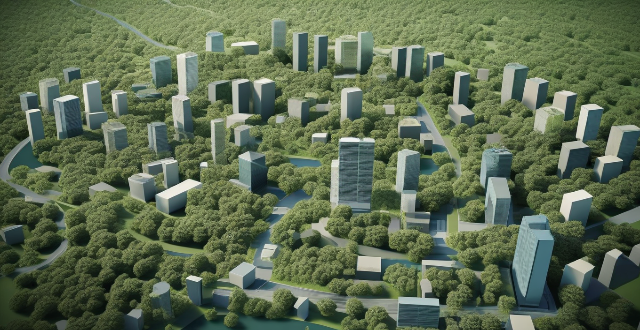Change Resilience

How can businesses contribute to climate resilience ?
Climate resilience refers to the ability of a system, community, or society to withstand and recover from the impacts of climate change. Businesses have a significant role to play in building climate resilience. Here's how they can contribute: 1. Reducing Greenhouse Gas Emissions: Businesses can invest in energy-efficient technologies and practices to reduce their carbon footprint. They can also switch to renewable energy sources like solar, wind, or hydroelectric power to significantly reduce greenhouse gas emissions. 2. Sustainable Sourcing and Production: Businesses can ensure that their suppliers adhere to sustainable practices, reducing the environmental impact of their products. By using resources more efficiently and reducing waste, businesses can minimize their environmental footprint. 3. Investing in Research and Development: Businesses can invest in research and development of clean technologies that can replace fossil fuel-dependent processes. Encouraging innovation within the company can lead to new solutions for reducing environmental impact and increasing sustainability. 4. Adapting to Climate Change: Businesses can design and build infrastructure that is resistant to extreme weather events caused by climate change. Implementing efficient water management systems can help businesses adapt to changing water availability due to climate change. Diversifying supply chains can reduce the risk of disruptions caused by climate-related events. 5. Advocating for Climate Action: Businesses can use their influence to advocate for policies that support climate resilience and sustainability. Collaborating with other businesses, governments, and non-governmental organizations can amplify efforts to build climate resilience. Raising public awareness about climate change and its impacts can help create demand for more sustainable products and services. 6. Community Engagement and Support: Providing education and training on climate resilience can empower communities to adapt to changing climate conditions. Supporting disaster preparedness programs can help communities cope with climate-related emergencies. Partnering with local organizations can help businesses understand and address the specific challenges faced by their communities due to climate change.

How does climate resilience relate to sustainable development ?
Climate resilience and sustainable development are interconnected concepts that aim to ensure the long-term well-being of our planet and its inhabitants. They share common goals, such as addressing global challenges like poverty, inequality, and environmental degradation by integrating short-term actions with long-term visions. Climate resilience refers to the ability of a system, community, or society to withstand and recover from the impacts of climate change, including extreme weather events such as hurricanes, floods, and droughts. It involves adapting to changing environmental conditions while maintaining essential functions and services. Key elements of climate resilience include adaptation, mitigation, preparedness, and recovery. Sustainable development is development that meets the needs of the present without compromising the ability of future generations to meet their own needs. It balances economic growth, social inclusion, and environmental protection for long-term prosperity. The three pillars of sustainable development are economic, social, and environmental. The intersection of climate resilience and sustainable development lies in their complementary goals, mutual benefits, integrated approaches, and policy coherence. Achieving climate resilience can support sustainable development by reducing vulnerabilities to climate change, which in turn can help maintain economic stability and protect livelihoods. Pursuing sustainable development can enhance climate resilience by promoting clean energy sources, efficient resource use, and robust ecosystems that can absorb the impacts of climate change. Integrating climate resilience into sustainable development strategies ensures that efforts to combat climate change are not isolated but rather part of a broader plan for sustainable living. This includes investing in renewable energy, building green infrastructure, and fostering sustainable agriculture practices. Governments and organizations must ensure policy coherence between climate action and sustainable development goals. By aligning policies, they can avoid conflicting objectives and maximize synergies between these two critical areas. In conclusion, climate resilience and sustainable development are not only compatible but also mutually reinforcing. Building resilience against climate change impacts is an integral part of achieving sustainability, just as pursuing sustainable pathways can strengthen our capacity to adapt and thrive in a changing climate. Together, they offer a comprehensive approach to securing a resilient and sustainable future for all.

What are the benefits of climate resilience ?
Climate resilience is crucial for adapting to climate change impacts and recovering from related damages. It offers economic, social, environmental, political, and cultural benefits. These include reduced damage costs, protection of assets, enhanced productivity, improved public health, community cohesion, continuous education, biodiversity conservation, resource stewardship, reduction of greenhouse gas emissions, increased government legitimacy, international leadership, policy innovation, preservation of heritage, strengthening of cultural practices, and promotion of cultural exchange. Building climate resilience ensures more robust, equitable, and sustainable futures.

How can climate resilience help mitigate the impacts of climate change ?
Climate resilience is a crucial strategy for mitigating the effects of climate change. It involves reducing vulnerability, enhancing adaptive capacity, promoting sustainable development practices, and fostering social cohesion. By implementing these strategies, communities can become more resilient and better able to cope with the impacts of climate change.

How can communities improve their resilience to climate change ?
Communities worldwide face challenges due to climate change, necessitating enhanced resilience. Key strategies include building awareness through education and training, upgrading infrastructure with sustainable solutions, conserving ecosystems, integrating climate considerations into planning, diversifying economies, and engaging communities in decision-making processes. These efforts not only help communities adapt but also contribute globally to combating climate change.

What role do governments play in promoting climate resilience ?
Governments play a crucial role in promoting climate resilience. They can take various actions to mitigate the impacts of climate change and build resilience among their citizens. Here are some ways governments can promote climate resilience: 1. Enacting and Implementing Policies - Reducing greenhouse gas emissions - Protecting natural resources - Investing in infrastructure 2. Providing Financial Support - Funding research and development - Providing grants and loans - Creating incentives for businesses 3. Educating the Public - Raising awareness - Training professionals - Promoting behavior change 4. Collaborating with Other Stakeholders - Partnering with NGOs - Engaging with the private sector - Working with international organizations

How can companies incorporate climate resilience into their workforce development strategies ?
Incorporating Climate Resilience into Workforce Development Strategies Climate resilience is essential for businesses to withstand and recover from climate-related stresses and shocks. Companies can build a resilient workforce by developing a climate resilience training program, integrating sustainability into company culture, enhancing adaptive capacity, building partnerships and collaborations, investing in technology and innovation, promoting health and well-being, and implementing resilience in operations. These strategies require a multifaceted approach that includes education, cultural integration, skill enhancement, partnerships, technological innovation, health promotion, and operational resilience. By taking these steps, companies can protect their business interests and contribute positively to the global effort in combating climate change.

What are some innovative examples of companies integrating climate resilience into their CSR frameworks ?
Incorporating climate resilience into corporate social responsibility frameworks is becoming increasingly important. Here are some innovative practices by companies like Unilever, Microsoft, Adidas, Tesla, and Patagonia to reduce environmental impact and build resilience against climate change effects.

How can we measure the effectiveness of climate resilience strategies ?
Measuring the effectiveness of climate resilience strategies is crucial for ensuring that communities and ecosystems are adequately prepared for the impacts of climate change. Key factors to consider when evaluating the success of these strategies include assessing impact reduction, monitoring adaptive capacity, evaluating systemic resilience, long-term sustainability, scalability and replication, and community engagement and perception. By considering these factors and using a combination of quantitative data analysis and qualitative assessments, we can comprehensively measure the effectiveness of climate resilience strategies. This will help in refining current approaches and informing future strategies to build a more resilient world in the face of ongoing climate change.

How do ecosystem-based adaptation methods contribute to climate resilience ?
Ecosystem-based adaptation (EBA) methods play a crucial role in building climate resilience by leveraging the natural capacity of ecosystems to mitigate and adapt to the impacts of climate change. These approaches focus on conserving, restoring, and promoting sustainable management of ecosystems to provide essential services that help communities cope with climate-related stresses. Below are several ways EBA methods contribute to enhancing climate resilience: Protection from extreme events, enhancement of biodiversity, promotion of sustainable livelihoods, regulation of water resources, carbon sequestration and storage, community empowerment and education, disaster risk reduction, and research and innovation.

How can civil society organizations contribute to building resilience against climate conflicts ?
Civil society organizations (CSOs) are essential in building resilience against climate conflicts through advocacy, awareness-raising, capacity-building, and community-based adaptation. They advocate for policies that promote climate resilience, raise awareness about climate change impacts, build community capacity to cope with climate stressors, and support community-led adaptation initiatives. CSOs collaborate with various stakeholders to ensure climate change is addressed in national and international agendas, disseminate information on climate risks and adaptation strategies, provide technical assistance and resources for locally-led projects, and engage in livelihood diversification, food sovereignty, and ecosystem conservation efforts. By working together, CSOs contribute to a more equitable and sustainable future.

What are some examples of successful climate resilience initiatives ?
Successful climate resilience initiatives include green infrastructure development, community-based adaptation programs, disaster risk reduction plans, integrated coastal zone management, climate-smart agriculture, and climate change education and awareness campaigns. These strategies aim to prepare for, respond to, and recover from the impacts of climate change by building the capacity of communities, ecosystems, and countries to withstand and adapt to climate-related stresses and shocks.

What are the factors that contribute to climate vulnerability ?
Climate vulnerability is influenced by various factors that can exacerbate the impacts of climate change and limit the ability of systems to adapt, including exposure to extreme weather events and sea level rise, ecosystem sensitivity, economic resources, infrastructure resilience, population density, dependency on climate-sensitive sectors, policy frameworks, access to information and technology, traditional knowledge, awareness and education, biodiversity loss, and land use changes. Addressing these factors through comprehensive strategies is essential for building resilience against the challenges posed by a changing climate.

How can we promote resilience in adolescents during their developmental years ?
The article discusses the importance of promoting resilience in adolescents to help them cope with various challenges during their developmental years. It suggests several strategies, including encouraging positive thinking, building problem-solving skills, promoting social support, encouraging participation in extracurricular activities, teaching emotion regulation skills, and promoting healthy lifestyle habits. These strategies can help adolescents develop the resilience they need to thrive during their developmental years.

What role does discipline in sports play in achieving personal goals and mental resilience ?
The text discusses the importance of discipline in sports for achieving personal goals and building mental resilience. It outlines key aspects such as setting clear objectives, consistent practice, overcoming obstacles, self-regulation, focus and concentration, and resilience under pressure. The article emphasizes that discipline not only enhances physical performance but also strengthens mental fortitude, enabling athletes to reach their full potential and thrive in their respective sports.

What strategies can coaches use to foster resilience and mental toughness in their athletes ?
Strategies for Coaches to Foster Resilience and Mental Toughness in Athletes: Emphasize the Importance of Mindset: Encourage positive self-talk, visualization techniques, and goal setting. Build a Supportive Environment: Create an open communication environment, promote teamwork, and provide constructive feedback. Teach Coping Mechanisms: Introduce stress management techniques, problem-solving skills, and time management strategies. Incorporate Adversity Training: Simulate pressure situations, discuss overcoming setbacks, and incorporate physical challenges. Lead by Example: Model resilience, share personal experiences, and show a commitment to continuous learning.

What is climate resilience ?
Climate resilience is the ability of systems, communities, or societies to adapt to and recover from climate change impacts. It involves measures like infrastructure upgrades, renewable energy use, disaster risk reduction, and financial investment. Benefits include economic stability, public health improvement, ecosystem preservation, and social cohesion.

What are the benefits of climate financing ?
Climate financing is crucial for mitigating climate change and adapting to its impacts. It supports projects that reduce GHG emissions and build resilience, stimulates economic growth through green investments, attracts private sector involvement, promotes international cooperation, helps achieve global climate goals, encourages innovation, builds resilience, contributes to SDGs, enhances policy coherence, and addresses environmental justice.

How can we build climate resilience in our communities ?
Climate resilience is essential for community sustainability and well-being. Building it involves education, sustainable infrastructure, ecosystem conservation, economic strategies, community engagement, and research. Efforts must be collective across all sectors to achieve a resilient and sustainable future.

How can we adapt to the impacts of climate vulnerability ?
Adapting to the Impacts of Climate Vulnerability: This article discusses strategies to adapt to the impacts of climate change, including understanding risks, building resilience, enhancing community capacity, and long-term planning. It emphasizes the importance of assessing potential impacts on sectors such as agriculture, water resources, health, and infrastructure, and implementing both structural and non-structural measures to build resilience. The article also highlights the crucial role of communities in adaptation and the need for comprehensive adaptation plans that consider future scenarios and incorporate feedback mechanisms for continuous improvement.

How can developing countries build resilience through climate adaptation ?
Developing countries can build resilience against climate change through sustainable infrastructure, renewable energy, sustainable agriculture, coastal and marine ecosystem enhancement, early warning systems, institutional capacity strengthening, and community education and empowerment.

How does climate change affect education ?
Climate change impacts education through extreme weather events, health issues, food insecurity, economic challenges, social changes, and environmental degradation. These effects necessitate collaboration between educators and policymakers to develop resilient strategies for adapting to climate change.

What role do women play in climate change adaptation and mitigation efforts ?
Women play a crucial role in climate change adaptation and mitigation efforts. They are involved in sustainable agriculture, conserving natural resources, enhancing energy efficiency, advocating for climate action, and building resilience. By recognizing and supporting their contributions, we can enhance our collective efforts to address climate change.

How is climate resilience incorporated into modern urban development projects ?
Incorporating climate resilience into modern urban development projects is crucial for ensuring the sustainability and longevity of cities. Key strategies include sustainable transportation, green infrastructure, energy efficiency, water management, and community engagement and education. By implementing these measures, developers can build cities that are better equipped to adapt to the challenges posed by climate change, ensuring the long-term viability of our cities.

How does climate change affect gender equality ?
The text discusses the impact of climate change on gender equality, highlighting increased vulnerabilities for women in health, economics, and social factors. It further points out how climate change exacerbates existing inequalities through gender-based violence and educational setbacks. However, it also identifies opportunities for resilience and empowerment through resilient livelihoods, enhanced participation, and improved health and safety measures. The conclusion emphasizes the importance of addressing climate change with a gender lens to achieve sustainable development and a more equitable future.

What challenges do developing countries face in achieving climate resilience ?
Developing countries face numerous challenges in achieving climate resilience, including economic, social, political, and environmental issues. These challenges range from limited financial resources and dependency on climate-sensitive sectors to weak healthcare systems and food insecurity. Additionally, lack of policy coherence, weak governance, and international pressure further complicate matters. Environmental challenges such as biodiversity loss, water scarcity, and increased frequency of natural disasters also pose significant threats. Addressing these interconnected issues through collaborative efforts is crucial for building more resilient societies capable of withstanding the adverse effects of climate change.

How does climate change affect biodiversity ?
This article explores how climate change affects biodiversity by altering ecosystems, species distribution, and genetic diversity. It discusses the impact of rising temperatures on habitat loss and altered precipitation patterns, ocean acidification on coral reefs and phytoplankton communities, and extreme weather events on fires and storms. The article also highlights the loss of genetic diversity due to reduced resilience and functional homogeneity in ecosystems, as well as inbreeding depression and genetic bottlenecks in species. Addressing climate change is essential for conserving biodiversity and maintaining healthy ecosystems.

How does climate change affect the construction industry ?
Climate change affects the construction industry in various ways, including increased extreme weather events leading to damage and costly repairs, changes in building codes and standards due to new environmental conditions, a focus on energy efficiency and sustainability, potential disruptions to labor availability and supply chains, and increased insurance costs. Builders and developers must adapt by embracing new technologies and practices that promote sustainability and resilience.

Can studying the psychological effects of climate change help in developing more effective adaptation strategies ?
This article explores how understanding the psychological effects of climate change can contribute to developing effective adaptation strategies. It outlines key areas such as impact on mental health, influence on behavioral change, public perception and awareness, community resilience, and policy making processes. By addressing these areas, it is possible to create more resilient and sustainable communities in the face of climate change.

How does climate change impact social justice ?
Climate change has significant impacts on social justice, affecting marginalized communities, health outcomes, economic stability, migration patterns, and gender equality. Mitigation efforts to reduce greenhouse gas emissions and adaptation strategies to build resilience against the impacts of climate change are necessary to create a more equitable future for all.